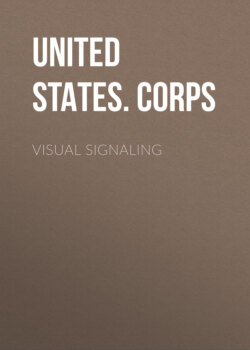Читать книгу Visual Signaling - United States. Army. Signal Corps - Страница 3
На сайте Литреса книга снята с продажи.
Chapter I.
ОглавлениеTable of Contents
INTRODUCTION.
While, in consequence of the development of electrical invention and improvement, visual signaling will be less frequently resorted to in future than heretofore in the service of field lines of information, it should be appreciated that the necessity for an adequate supply of apparatus of this kind, and the need for skilled manipulators to operate it, has in no wise diminished. The great celerity with which electric signals can be exchanged and their usual entire independence of local conditions has placed systems of this class foremost among the signaling methods of the world. There is scarcely any commercial industry whose successful existence does not vitally depend upon some one, perhaps several systems of signaling, and improvements of old and inventions of new signal devices are continually necessary to meet the requisite needs demanded by the progress of art and science. Railways are probably the greatest of all commercial users of signals. With them the great mass of intelligence is transmitted by the electric telegraph and telephone, but the flag, the semaphore, the signal light, and many other contrivances furnish indispensable visual adjuncts. Visual signaling is and always will be a most valuable means of transmitting information in peace and war, and it is not to be imagined that it will ever be supplanted in its particular function by the introduction of other methods. Occasions will frequently occur in the field when no other means will be practicable, and then, if not before, will the value of the system be fully emphasized.
Strictly speaking, a visual signal is any visible sign by which intelligence is communicated, but in a military sense the term visual signaling has a broader meaning and includes other methods of transmitting information than those which appeal to the sense of sight.
In most systems of signals suitable for military use, each signal is composed of one or more separate units, known as elements. Having prescribed a certain number of elements, the various signals are formed by having these elements appear singly or together in different arrangements or combinations. The continental system is one of two elements, namely the dot and the dash, while the Morse system employs three elements, the dot, the dash, and the space. Having agreed upon a certain number of combinations of elements, a system of signals is formed by giving a meaning to each combination. These meanings usually include the letters of the alphabet and numerals, combinations of which being used to formulate necessary information. Combinations of elements of any system can also, however, be used to indicate any desired meaning.
With reference to period of visibility, signals are of two kinds, transient and permanent. A transient signal is one which disappears as soon as completed; a permanent signal is one that remains in view for some time. Heliograph signals are transient signals, while signals made by code flags are permanent signals. Signals are divided into classes in accordance with the number of elements employed in their formation. Thus, signals using two elements are signals of the second class, signals using three elements signals of the third class, etc.
The standard apparatus used in visual signaling is fully described in a succeeding chapter. Some of the instruments employed are used wholly for day, and some wholly for night, signaling. Some devices, either with or without slight variations, are equally well adapted to day or night work. Visual signaling presents a great field for ingenious and resourceful work, and emergency will often demand the advantageous employment of other methods than those described herein.
